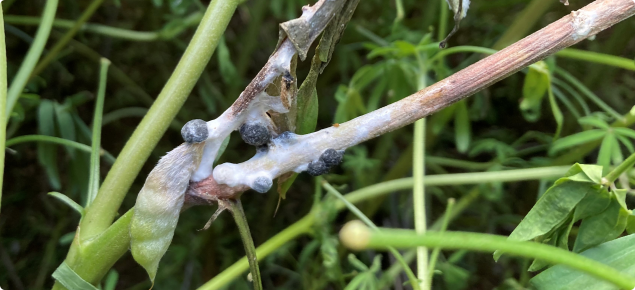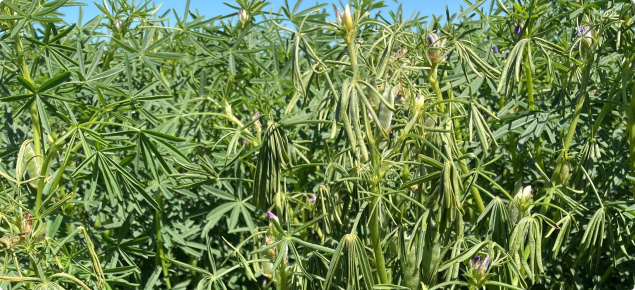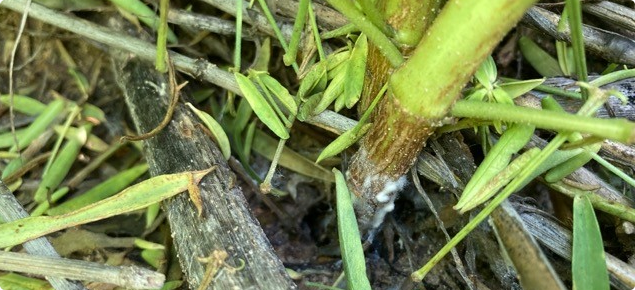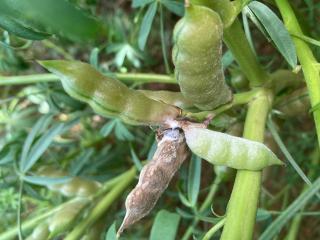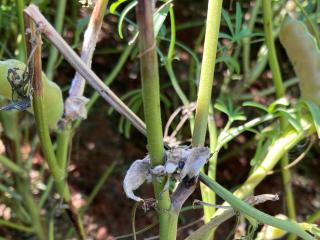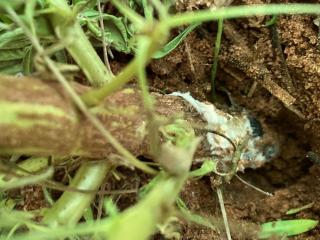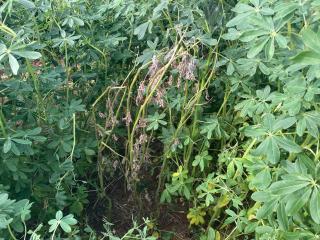Symptoms in lupin
Sclerotinia stem rot (Sclerotinia sclerotiorum) is a fungal disease which infects most broad leaf crop and pasture species but not cereals. Canopy infection in lupin can occur on the stem and branches but the main yield limiting infection has been found to be infection immediately underneath or on the main spike including pods and lateral branch pods. Infected plant parts are often covered by white fungal growth and black sclerotia may be visible outside and inside branches and pods. Pods may be aborted or shrivelled on infected plants. Sclerotinia infection can also occur at ground level (basal infection) which causes plants to appear wilted and the whole plant may die and appear bleached. When pulled up out of the ground the plants display recognizable white fungal growth on the stem at ground level and sometimes on the roots. Harvested grain may be contaminated by sclerotia when disease levels are high. Sclerotinia survives as sclerotia (hard, dark resting bodies of the pathogen) in the soil for many years and can germinate to spread further disease (Figure 1). More information on diagnosis is available from Diagnosing sclerotinia stem rot in lupins and field peas. The disease lifecycle is described under 'Risk Factors'.
Distribution and severity of sclerotinia in lupin in WA
Historically in Western Australia (WA), sclerotinia in lupin was an issue in the Geraldton port zone only but, with more canola being grown across the WA wheatbelt, the disease is now found in many areas and appears to be becoming a more regular issue. Regional disease surveillance has found sclerotinia in lupin is generally a problem in wetter growing seasons in areas where lupins are grown in close rotation with canola that has previously been infected with sclerotinia.
2021 and 2022 commercial crop surveillance conducted by DPIRD
Annual disease surveillance of commercial lupin crops was conducted in the spring of 2021 and 2022 with results of prevalence presented in Tables 1 and 2. Surveillance has found Sclerotinia sclerotiorum distributed across the WA wheatbelt but the potential for significant yield impact appears greatest in the medium and high rainfall zones of the Kwinana North and Geraldton port zones where infection occurs earlier in the season and generally at higher incidence.
Crop surveillance was a joint effort by the Disease surveillance project and the Lupin Sclerotinia project and involved surveying 51 lupin crops in 2021 and 49 lupin crops in 2022 across the port zones shown in Figure 1. In each crop 25 random plants were assessed for disease incidence and severity. All crops were narrow leaf lupin except for a very small proportion of the Geraldton port zone crops being Albus lupin.
| Percentage of surveyed lupin crops infected with sclerotinia in spring | ||||||
|---|---|---|---|---|---|---|
| 2021 | 2022 | |||||
| Port Zone | Basal | Canopy | Total | Basal | Canopy | Total |
| Kwinana | 13 | 20 | 27 | 38 | 75 | 88 |
| Albany | 10 | 70 | 80 | 17 | 67 | 67 |
| Geraldton | 90 | 95 | 100 | 40 | 87 | 93 |
| Esperance | 25 | 25 | 50 | 50 | 50 | 50 |
| Across all port zones | 47 | 63 | 71 | 22 | 44 | 53 |
| Incidence of sclerotinia infected plants within infected crops (%) | ||||
|---|---|---|---|---|
| 2021 | 2022 | |||
| Port Zone | Basal | Canopy | Basal | Canopy |
| Kwinana | 8 | 24 | 1 | 7 |
| Albany | 4 | 4 | 1 | 4 |
| Geraldton | 11 | 41 | 3 | 26 |
| Esperance | 8 | 4 | 4 | 2 |
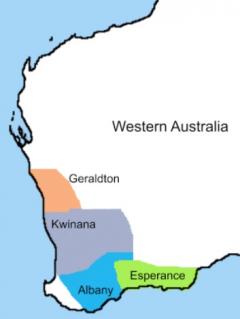
2022 surveillance
The 2022 season was characterised by an early start (storms brought significant rain in late March), dense crops with early canopy closure in most areas and above average rainfall in late winter and spring (long soft finish to the season and above average yields across most of WA wheatbelt).
Infection with Sclerotinia sclerotiorum was by far the most common disease recorded in lupin disease surveys in 2022. The prevalence and incidence of this disease was less than 2021 but higher than other years. In particular, basal infection was less damaging than in 2021. As in previous seasons, the Geraldton port zone had greatest prevalence of sclerotinia infection, however in 2022 the Kwinana region also had significant infection (both canopy and basal), a large increase on what was seen in 2021 surveys. In Kwinana south 67% of paddocks surveyed in 2022 had sclerotinia (canopy and/or basal) whereas in 2021 no southern paddocks had infection. In Kwinana north 92% of paddocks surveyed had sclerotinia, whereas in 2021 it was 60%. In Kwinana east 100% of paddocks surveyed had sclerotinia whereas in 2021 it was only 17%.
In the Albany port zone 67% of lupin crops surveyed had sclerotinia canopy infection with 17% having basal infection, but as in 2021, both types of infection occurred late in the season and at low incidence and severity within paddocks most likely due to the cooler winter temperatures in the south compared to Kwinana and Geraldton in the north. Other diseases including bean yellow mosaic virus (BYMV), brown spot and botrytis grey mould (BGM) were more common than sclerotinia in the Albany port zone.
Incidence of sclerotinia infection was high in the Geraldton port zone in 2022 where canopy infection was found in 87% of lupin paddocks surveyed and basal sclerotinia was found in 40% of paddocks surveyed (basal incidence half of what was seen in 2021). Incidence and severity was lower than in 2021 with many lupin crops having branch infection rather than main pod infection minimizing impacts to yield.
In the Geraldton port zone, sclerotinia infection was delayed due to a warm and dry May/June period resulting in the delayed release of ascospores (carpogenic germination of sclerotia) not overlapping with crop flowering in most early sown crops. Due to the early break (end of March) majority of crops were sown in early to mid April and so were flowering on the main spike in June escaping infection before the sclerotinia disease cycle commenced. Despite crops developing dense, thick canopies and late winter and spring being significantly wetter than average, sclerotinia was late to develop and in most crops its understood that it did not cause significant yield loss. Crops were huge and very high yielding and likely compensated for any pods lost to sclerotinia. Other diseases including Phomopsis and anthracnose were found at significant levels in spring in many paddocks surveyed favoured by ongoing moisture.
2021 surveillance
In 2021, prevalence of lupin sclerotinia infection was extremely high in lupin crops surveyed in the Geraldton port zone (GPZ) and canopy infection was found in 95% of commercial lupin paddocks surveyed and basal (ground level) sclerotinia was found in 90% of paddocks surveyed (Table 1). Within infected paddocks incidence and severity was high in some lupin crops with pod infection common, closely associated with pod abortion, which reduced yield (Table 2). In 2021, there were reports of several growers in the GPZ having to grade sclerotia out of their grain in order to meet CBH delivery standards. In the Albany port zone, prevalence of sclerotinia was high (70% of surveyed paddocks) but disease infection was late in the season and and at low incidence and severity within paddocks with negligible basal infection evident (Tables 1 and 2). Surveyed paddocks and trials conducted in the region showed no significant yield loss from sclerotinia was likely. Lupin sclerotinia infection was found to be at low incidence in surveillance conducted in the Esperance port zone, only 4 crops were surveyed due to limited area sown to lupin.
Agronomists reported significant levels of basal infection were common in lupin crops around Moora, York/Avon Valley, Wongan Hills areas, and out to Merredin. DPIRD observed lupin sclerotinia at Badgingarra, Bolgart, Walebing, Buntine and Konnongorring in the Kwinana north port zone.
The 2021 growing season was characterized by an early start, dense crops and above average rainfall in most parts of WA where lupins are grown. In a season where moisture and humidity were not lacking for the most part in all port zones, it was evident that temperature appears to be an important driver for the sclerotinia infection process and if conditions are too cold (<16°C) in winter, which is what occurred in the Albany port zone, infection will be delayed. As a result, there was no recorded yield impact or fungicide response in field trials conducted in the Albany port zone.
Previous years
Lupin sclerotinia was present in the Geraldton port zone in some crops in 2020 (canopy infection found in 50% of paddocks surveyed and basal infection in 30% of paddocks surveyed) and there were also reports from Kojonup, Brookton and Esperance that year. Geraldton port zone had more of a widespread issue with the disease in 2016 and 2018 but it was not reported from other port zones. There was one report from the North Stirlings area of the Albany port zone in 2015.
Risk factors associated with crop infection
Collaborative research by DPIRD, Mingenew Irwin Group (MIG) and Centre for Crop and Disease Management (CCDM) is currently being conducted as part of a four-year GRDC coinvested project Sclerotinia management for narrow leaf lupin crops in Western Australian farming systems (DAW2104-002RTX). The project commenced in 2021 and DPIRD funding allowed for the inclusion of albus lupin research in the first two years.
The first two years of the research project have defined the growing season weather conditions and the crop/paddock characteristics that pose a high risk of sclerotinia infection to lupin. This information is now available in a GRDC factsheet Lupin sclerotinia disease risk assessment guide published as part of this project.
Paddock/crop risks
Research to date has found that sclerotinia risk is usually higher in lupin crops grown in paddocks that have:
- a previous history of the disease (eg within the last 5 years)
- high plant density, and bulky crop
- loamy/clay-loam soil type (allows humidity levels to build up from ongoing soil moisture)
- early canopy closure
- good yield potential.
Time of Sowing - In trials sown at Geraldton in 2021 and 2022, sclerotinia canopy infection was found to be significantly higher when lupins (narrowleaf or albus) were sown early (mid-April) compared to later (early May) but further research in other seasons is required to determine if this is a common trend.
Lupin species (Narrowleafed lupin vs Albus lupin) - Albus lupin (Lupinus albus) does not have the extensive canopy cover or consistent under canopy humidity that narrowleafed lupin (Lupinus angustifolius) has however, a yield response to fungicide is more likely in Albus lupin due to vulnerability to anthracnose infection (highly damaging) which fungicide application at flowering / podding can also reduce.
Weather conditions, disease lifecycle and geographical location
Lupin sclerotinia development is highly dependent on seasonal weather conditions, maybe even more than canola sclerotinia, and only develops in years where there is sufficient rainfall across the growing season. Favourable rainfall, humidity and temperature conditions are required at all stages of the sclerotinia lifecycle (Figure 2) for it to initiate, persist and spread. Infection can develop extremely rapidly within weeks under favorable weather conditions and can be difficult to manage with foliar fungicides when high disease pressure present.
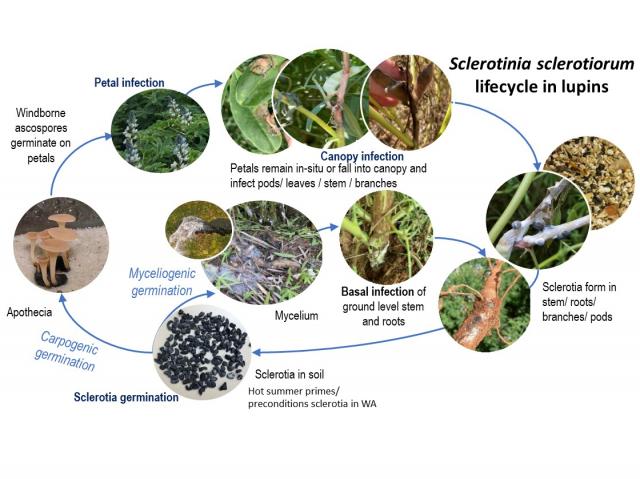
Close to average autumn and early winter rainfall is necessary for: a) good emergence and establishment of dense lupin crops which favours high humidity levels under the canopy to suit sclerotinia and b) sclerotia to germinate carpogencially and form apothecia which spread ascospores initiating the disease cycle. Continuing regular rainfall and high relative humidity during winter and spring is needed to: a) favour presence of apothecia persisting under the crop canopy to coincide with crop flowering in order for ascospores to infect petals and b) opportunity for petals to infect canopy of dense lupin crops of good yield potential where c) stem/branch/pod infection occurs and spreads to yield limiting levels especially favored by a wet/humid end to the season. So, years of below average rainfall or where dry periods occur during crucial parts of the disease cycle (such as autumn and spring) will limit or prevent development and spread of sclerotinia in lupin. Wet growing seasons that produce high lupin yields are also the years where sclerotinia disease levels are likely to be significant. In wet growing seasons a second infection pathway can occur if soils stay saturated for at least a week. Sclerotia can germinate myceliogenically (direct infection by fungal hyphae) and infect lupin stems at ground level, this is known as basal infection and can cause the death of the whole plant.
Distinct differences in the sclerotinia disease cycle and disease levels in lupin in the Geraldton port zone (GPZ) versus the Albany port zone (APZ) were observed by DPIRD in 2021 and 2022. In both growing seasons, moisture and humidity were not lacking for the most part in all port zones so temperature was clearly a key driver. Geographical differences in incidence help to illustrate the impact that local seasonal weather conditions have on disease development. In the Albany port zone, sclerote germination in DPIRD sclerote depots was not observed until late winter (early August) and continued until October. Winter temperatures were too cool at the Albany port zone trial sites (<16°C), delaying initiation of crop infection to September/October by which time the crops were finishing up flowering. In the APZ, sclerotinia did not develop to yield limiting levels in either year. In the Geraldton port zone, early breaks in both years allowed lupin crops to emerge early with apothecia observed from late June to late August. Both canopy infection and basal infection were observed with mild winter temperatures greater than 16°C in most areas creating a large window for crop infection to occur while crops were still flowering. Many sites developed symptoms from July. Crops were dense and high yielding and sclerotinia caused significant yield impact in some crops (on average at least 6% yield loss) in the GPZ.
The economic and yield impact from lupin sclerotinia
Field research conducted by DPIRD and growers since 2016 has observed that the main yield impact of canopy sclerotinia in lupin is infection on the main spike and lateral pods. This differs from canola where the impact of the disease is predominantly from infection on the main stem. Research has found the yield loss caused by sclerotinia canopy infection in lupin is variable, ranging from 0-25% in field trials across a range of different growing seasons.
In the Geraldton port zone, a single foliar fungicide application for control of canopy sclerotinia in lupin provided an average yield response of 11% in trials conducted in 2021-22, generally where sclerotinia incidence was significant (ie >30% of plants infected). A summary of field trial research results conducted across a range of locations is available from this page under 'Documents'. Future research will try to quantify the losses caused by basal (ground level) infection as it depends when in the season and what growth stage it occurs at. An initial experiment conducted in 2023 in transparent perspex tubes inoculated with sclerotia has shown that basal sclerotinia (caused by mycelial germination of sclerotia) may cause damage to lupin shoot and root growth - see the report on this experiment under 'Documents'. This research into basal infection infection process and yield impact is continuing in the field and controlled environment rooms.
Damaging disease levels of sclerotinia in lupin are hard to predict, making decisions on value of management in each cropping situation challenging. Crop risk criteria have been described above to assist with decision making and are outlined in the Lupin sclerotinia disease risk assessment guide.
Sclerotia left behind in the soil after crop infection are an ongoing disease risk for future broad leaf crops sown in that paddock. Grading sclerotia out of harvested grain in order to meet delivery standards or for using as a seed source is an added headache and cost that can result from the disease. DPIRD research is trying to quantify the sclerotia burden left behind after lupin vs canola and the impact of different crop rotations on sclerotinia development.
Disease management
DPIRD are evaluating a range of potential management options including cultural, agronomic, and chemical for the development of an IDM package for WA lupin growers. The following recommendations are based on research/observations to date but research is continuing:
Crop rotation
- Incorporate non-hosts or lower-risk crops into the crop rotation e.g. cereals.
- Separate last year’s infected canola/lupin stubble and new seasons’ crops by preferably 500m.
Clean seed
- Always sow seed free of sclerotia, grade retained seed if necessary.
Crop management
- Earlier sown crops may be prone to developing more severe infection but this is dependent on the weather conditions, particularly rainfall, each growing season.
- Reduced seeding rates may increase air-flow through the canopy.
Foliar fungicide strategies
- Foliar fungicides registered in lupin may be helpful for reducing sclerotinia canopy infection. Foliar fungicides reduce canopy disease but may not necessarily give a yield benefit. Foliar fungicide application, targeted at canopy infection, generally does not provide any reduction in ground level (basal) sclerotinia infection.
- Foliar fungicides should be timed to protect main stem pods and branch pods.
- A range of products are now registered in lupin including Veritas® Opti, Amistar® Xtra and Miravis® Star and can reduce sclerotinia canopy infection. For more information, view the Registered foliar fungicides for lupin and other pulse crops in Western Australia webpage.
If a lupin crop meets the high risk criteria (described in the Lupin sclerotinia risk assessment guide) AND there is an outlook for ongoing moist and humid weather conditions with temperatures 16 - 25°C fungicide application may be profitable.
In field research trials conducted by DPIRD, MIG and growers from 2016-2022, several foliar fungicides significantly reduced sclerotinia infection and severity in the upper canopy when applied during flowering or at early pod emergence on the main spike. Application at this time was observed to predominantly reduce infection on the main spike and lateral pods but in most cases did not significantly reduce basal (ground level) infection. In these trials, yield responses of 4-11% from a single foliar fungicide application were common but it should be noted that a yield response is not guaranteed. Larger yield responses (up to 25% or higher) from foliar fungicide application have been achieved in some cases when applied at optimal time, other diseases were present (especially damaging ones like anthracnose for Albus lupin), and the season finished with a wet spring. Yield and/or quality response to foliar fungicide application for sclerotinia are more likely if other diseases such as phomopsis or anthracnose are present as they are also managed by the same active ingredients, particularly with late season timings. In field trials conducted in the Geraldton or Kwinana port zones in 2021-2022, yield responses of 4-23%+ were recorded from a single foliar fungicide application in six out of fourteen trials conducted where sclerotinia was the dominant disease. Sclerote contamination in grain was significantly reduced by foliar fungicide application in only three out of fourteen trials conducted in 2021-2022. A summary of results of field trial research conducted across a range of locations in 2021-2022 is available from this page under 'Documents'.
Research has found that sclerotinia can develop extremely rapidly within lupin crops if favourable weather conditions and moisture continue. Profitable response to foliar fungicide application is more likely if applied prior to widespread infection developing (vulnerable crop growth stage coinciding with favourable weather events).
Recommendations from research conducted so far are detailed below. If a crop is considered high risk (see GRDC factsheet Lupin sclerotinia risk assessment guide) and favourable weather conditions (moist and temperatures between 16 and 25 degrees celcius) are expected to continue:
- Aim to apply foliar fungicides from full to late flowering/early pod emergence on the main spike. This timing aims to protect main stem pods and penetrate the canopy which gets bulky and hard to penetrate at later growth stages. A range of foliar fungicides are now registered in lupin and can be viewed on the DPIRD lupin and other pulses foliar fungicides webpage.
- Use high water rates (at least 100L/ha) to achieve good coverage and penetration into the canopy
- Where possible, apply fungicide before a rainfall event as fungicides are most effective before significant infection is present.
- In a favourable season, if an application hasn’t been done prophylactically, foliar fungicide should be applied as soon as possible after disease symptoms are observed in the canopy as the infection can develop rapidly if weather conditions continue to be conducive.
There are no in-furrow or seed dressing fungicides registered, or thought to be effective, for sclerotinia in lupin.
Research being conducted
Research is currently being conducted as part of a four-year GRDC funded project Sclerotinia management for narrow leaf lupin crops in Western Australian farming systems (DAW2104-002RTX). DPIRD funding is allowing for the inclusion of albus lupin research. DPIRD and Mingenew Irwin Group (MIG) with lupin growers are conducting field research in the Geraldton, Kwinana and Albany port zones, and DPIRD and Centre for Crop and Disease Management (CCDM) are also conducting lab and glasshouse studies.
Both canopy infection and basal (ground level) stem infection are being investigated. Factors influencing disease development being investigated include: time of sowing, fungicide timing and fungicide active ingredients, crop rotation, position in the landscape, lupin species, soil type, weather conditions and geographical location.
The project is also utilising the skills and networks of agronomists, MIG and growers to establish on-farm research activities and extend project results to the growers impacted by lupin sclerotinia.
Research goals (2021-2024):
- Gather data on the distribution and economic/disease impact from sclerotinia in commercial lupin crops
- Understanding the epidemiology and the infection process of sclerotinia in lupin (canopy and basal infection): the conditions leading to infection, effect of temperature, sites of infection on the plant, effect of plant stage on susceptibility to infection, conditions favouring sclerotia germination, sclerote development and latent periods. Studies are being conducted in the field and in controlled environment activities to generate information on the epidemiology of sclerotinia in lupins and how the disease cycle could potentially be interrupted in the canopy and at ground level (basal).
- Evaluating a range of potential disease management options (eg cultural, agronomic and chemical). Research is investigating how on-farm practices influence disease development - modifying some such as crop rotation, increased row spacing, lower plant densities and altered sowing time may provide some disease control and/or reduce fungicide usage. Ultimately by project end (2025) the aim is to develop practical and cost-effective integrated disease management packages for WA lupin growers and advisers.
- Investigate the effectiveness and optimum timing of fungicides for managing sclerotinia in the canopy and investigate if fungicides can have any impact on managing basal (ground level) sclerotinia.
Acknowledgements and disclaimer
The information presented here includes results of three GRDC coinvested projects - Sclerotinia management for narrow leaf lupin crops in Western Australian farming systems (DAW2104-002RTX, a collaboration of DPIRD, Mingenew Irwin Group, and Centre for Crop and Disease Management), Disease epidemiology, modelling and delivery of management decision support tools (DAW2112-002RTX), and Integrated disease management in western region grain crops (DAW1907-001RTX). Thank you to all growers who have hosted field trials or surveillance sites on their properties.
Mention of trade names does not imply endorsement or preference of any company’s product by Department of Primary Industries and Regional Development. Any omission of a trade name is unintentional. Recommendations are current at the time of publication.


